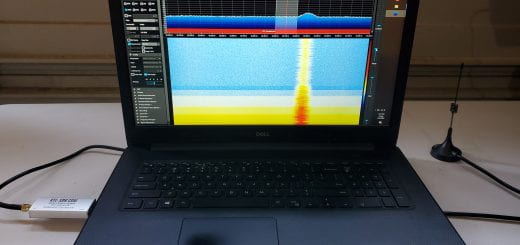AC Current, Detecting it Both Ways

AC Current Sensor
Detecting it Both Ways
Makerspaces are phenomenal hands-on learning spaces. They make it easy to teach what some might consider to be extremely abstract subjects like electronics, particularly if an instructor encourages the building of elucidating things, things like sensors that can then be used to detect and collect data about other objects. Of these, my favorite sensor to build is an AC or alternating current detector. A simple one can be built with just a few electronic components. In the process, the students learn about the components, how they function in the sensor, and how they alter to flow of electricity to do the job. The list of components is a simple as three resistors, three transistors, a tiny LED light bulb, a battery, and an inch of extra wire for an antenna.
There a just a few concepts that can be easily explained to show how the sensor works.
First, electrons passing through an LED as electricity excite the material inside and causes it to emit light. But it only does so when electrons pass through in one direction. In a sense they are passing through a one-way valve. If no electrons are passing through, there is no light.
Second, alternating current in wires generates very small amounts of magnetic energy around the wires the current is passing through. This magnetic field in turn can generate detectable but extremely low amounts of electric current in conductive materials like copper wire. Indeed, when we spin highly magnetic objects in copper wire, say by the use of wind or water turning the magnets, we can power cities.
Finally, transistors connected together in a string act as an amplifier. The easy way to imagine this is to think of series of three lined up Dominoes. When one falls, it knocks over the second Domino which in turn knocks over the third one. Now imagine that first domino is very small, but big enough that when if falls over, its kinetic energy is enough to knock over the second Domino which is significantly bigger, but no so large as to stop the fall of the first domino. So, now the second Domino falls and knocks over the third and even larger domino. In just one step we created an amplifier, but in series of steps we created a very large amplifier. Given a large number of increasing sized Dominoes we could use a blade of grass to crush a dump truck.
In the case of our AC circuit detector, the mild magnetic field around AC wires can induce very small currents in the copper wire of our sensor. If the magnetic field is strong enough, the current generated in the wire “flips a switch” in the transistor to allow current from the battery to flow through the transistor. This current in turn flips a switch in the second transistor allowing even more current from the batter to flow through the 2nd transistor which in turn does the same for the third transistor. At this point there is enough current flowing through the system to light the LED bulb showing that the system is detecting AC current. In fact, there is a million-fold increase in current initially detected in that short piece of wire, through this process. The resistors help protect the system getting from damaged by too much current.
So, what would happen if we used just two transistor or used four transistors. Well, two transistor may not amplifier the signal enough. That means you might need to have the sensor very close to AC wires to detect or signal or that it can’t detect one at all. In our domino analogy, it would mean that we can’t knock over the first domino to get the process started. If we used 4 transistors, the system might just stay on all the time. Think of a windy day where you can’t keep the wind from knocking over that first very small domino. In the parlance of Goldilocks, it has to be just right.


